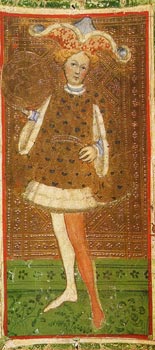To master the art of dancing, it was necessary for the dancer to consider
the following six elements:

MISURA (MEASURE)
meaning that the dancer should move harmoniously with the sound and the beat
of the music. The four tempo measures are the bassa danza, quadernaria, saltarello
and piva.
MEMORIA which means simply that the dancer must remeber the choreography
and the sequence of steps.
PARTIRE DI TERRENO by which is meant that the dancer needs to be fully
aware of the room in which s/he's moving, so that s/he can adapt hir steps to
the size of the available space [it is therefore more difficult to dance well
in a small than in a large room, because the former demands greater attention
to spatial subdivisions and general contex.
AIERE (AIRINESS) meaning a slowly rising movement (sort of natural
relevÈ) at the onset of each step and a rapid descending movement at the end,
so that a flowing horizontal movement is achieved, like a gondola on quiet water.
MANIERA a contrary movement of the upper body in relation to the steps.
MOVIMENTO CORPOREO what is meant here is that 'the perfect dancer'
has a well-proportioned, agile and supple body. This is regarded as an expression
of the ideal conditions for bringing this art to the ultimate level of perfection.
Ensemble Saltarello | back to index